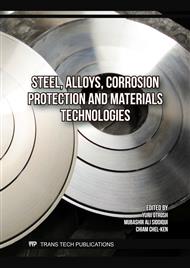[1]
D. G. Tregubov, D. V. Miroshnichenko, Methods of decrease in sulfur content in coke (review). Koks i Khimiya. 6 (2005) 21–28.
Google Scholar
[2]
K. Afanasenko, A. Romin, Yu. Klyuchka, Kh. Hasanov, V. Lypovyi, Epoxidized dinaphthol application as the basis for binder with advanced carbonation level to reducing its flammability. Materials Science Forum. 1006 (2020) 41–46.
DOI: 10.4028/www.scientific.net/msf.1006.41
Google Scholar
[3]
T. Shnal, S. Pozdieiev, S. Sidnei, A. Shvydenko, Determination of the Charring Rate of Timber to Estimate the Fire Resistance of Structures at Real Temperature Modes of Fires. Lecture Notes in Civil Engineering. 100 (2021) 409–418.
DOI: 10.1007/978-3-030-57340-9_50
Google Scholar
[4]
M. Zmaha, S. Pozdieiev, Y. Zmaha, O. Nekora, S. Sidnei, Research of the behavioral of the wooden beams with fire protection lining under fire loading. Materials Science and Engineering. 1021/1 (2021) 012031.
DOI: 10.1088/1757-899x/1021/1/012031
Google Scholar
[5]
A. Chernukha, A. Teslenko, P. Kovaliov, O. Bezuglov, Mathematical modeling of fire-proof efficiency of coatings based on silicate composition. Materials Science Forum. 1006 (2020) 70–75.
DOI: 10.4028/www.scientific.net/msf.1006.70
Google Scholar
[6]
O. Skorodumova, O. Tarakhno, O. Chebotaryova, Y. Hapon, F. M. Emen, Formation of fire dretardant properties in elastic silica coatings for textile materials. Materials Science Forum. 1006 (2020) 25–31.
DOI: 10.4028/www.scientific.net/msf.1006.25
Google Scholar
[7]
O. Skorodumova, O. Tarakhno, O. Chebotaryova, O. Bezuglov, F. Emen, The use of sol-gel method for obtaining fire-resistant elastic coatings on cotton fabrics. Materials Science Forum. 1038 (2021) 468–479.
DOI: 10.4028/www.scientific.net/msf.1038.468
Google Scholar
[8]
NFPA 921. Guide for Fire and Explosion Investigations. Quincy: National Fire Protection Association, 2024.
Google Scholar
[9]
V. A. Mykhailyk, Yu. F. Snezhkin, O. I. Oranska, T. V. Korinchevska, D. M. Korinchuk, Study of the thermal properties of solid residues of milled peat after the humus substances extraction. Thermophysics and Thermal Power Engineering. 37/3 (2015) 54–64 [in Ukrainian].
DOI: 10.31472/ihe.3.2015.07
Google Scholar
[10]
M. Suzanne, G. Erez, M. Chaouchi, Ch. Bretonnet, A. Thiry, Relationship between char depth of wood and cumulative heat exposure for fire investigation. Fire Safety Journal. 140 (2023) 103856.
DOI: 10.1016/j.firesaf.2023.103856
Google Scholar
[11]
ISO 5660-1, Reaction-to-fire tests, International Standard. Geneva: Vernier, 2021.
Google Scholar
[12]
E1354-23, Standard Test Method for Heat and Visible Smoke Release Rates for Materials and Products Using an Oxygen Consumption Calorimeter. West Conshohocken: ASTM International, 2024.
DOI: 10.1520/e1354-16a
Google Scholar
[13]
ISO 18894:2018, Coke – Determination of coke reactivity index (CRI) and coke strength after reaction (CSR), International Standard. Geneva: Vernier, 2024.
DOI: 10.3403/30348326
Google Scholar
[14]
D. G. Tregubov, D. V. Miroshnichenko, M. L. Ulanovskij, Thermomechanochemical evaluation of quality of coke. Koks i Khimiya. 11 (2004) 14–19.
Google Scholar
[15]
Sposib kompensatsiynoho dyferentsiyno-termichnoho analizu teplovykh efektiv: pat. 82249 UA. / Trehubov D.H., Tarakhno O.V., Zhernoklʹov K.V.; Application filed and Current Assignee by NUCP of Ukraine – u 2013 01866; Priority to 15.02.2013; Publication of 25.07.2013, №14. [in Ukrainian].
Google Scholar
[16]
DSTU 8831:2019, Koks, Metod vyznachennya pytomoho elektrychnoho oporu poroshku koksu kamʺyanovuhilʹnoho. K.: UkrNDNTS, 2019 [in Ukrainian].
Google Scholar
[17]
Sposib elektrychnoyi otsinky yakosti koksu: pat. 116026 UA. / Trehubov D.H., Hapon YU.K., Dadashov I.F., Chyrkina-Kharlamova M.A., Sharshanov A.YA., Minsʹka N.V., Trehubova F.D.; Application filed and Current Assignee by NUCP of Ukraine. - u 2023 04462; Priority to 21.09.2023; Publication of 01.05.2024, № 18. [in Ukrainian].
Google Scholar
[18]
D. G. Tregubov, Application of the thermal testing method of materials in the rotating chamber. Problems of fire safety. 34 (2013) 161–166 [in Ukrainian].
Google Scholar
[19]
F. Meng, S. Gupta, D. French, P. Koshy, Ch. Sorrell, Y. Shen, Characterization of microstructure and strength of coke particles and their dependence on coal properties. Powder Technology. 320 (2017) 249–256.
DOI: 10.1016/j.powtec.2017.07.046
Google Scholar
[20]
D. Tregubov, O. Tarakhno, V. Deineka, F. Trehubova, Oscillation and Stepwise of Hydrocarbon Melting Temperatures as a Marker of their Cluster Structure. Solid State Phenomena. 334 (2022) 124–130.
DOI: 10.4028/p-3751s3
Google Scholar
[21]
Yu. Hapon, D. Tregubov, E. Slepuzhnikov, V. Lypovyi, Cluster Structure Control of Coatings by Electrochemical Coprecipitation of Metals to Obtain Target Technological Properties, Solid State Ph., 334 (2022) 70–76.
DOI: 10.4028/p-4ws8gz
Google Scholar
[22]
D. B. Wiedemeier, S. Abiven, W. C. Hockaday, M. Keiluweit, M. Kleber, C. A. Masiello, Aromaticity and degree of aromatic condensation of char. Organic Geochemistry. 78 (2015) 135–143.
DOI: 10.1016/j.orggeochem.2014.10.002
Google Scholar
[23]
Quickly find chemical information from authoritative sources, Pubchem, U.S. National Library of Medicine. Information on https://pubchem.ncbi.nlm.nih.gov/
Google Scholar
[24]
D. G. Tregubov, S. A. Slobodskoj, The study of microarc discharge electric characteristics in wastewater treatment. Koks i Khimiya. 9 (1997) 32–34.
Google Scholar
[25]
Li Kejiang, B. Mansoor, Z. Jianliang, T. Liu, T. Yang, Advanced coke quality characterization and cokemaking techniques based on in depth understanding of coke behavior inside blast furnace, AIS Tech. Proceeding, Pittsburgh, Pennsylvania, USA, (2016) 273–283.
Google Scholar
[26]
I. V. Shulga, I. V. Miroshnichenko, I. M. Ryshchenko, D. V. Miroshnichenko, Moisture content of wet-quenched coke. Coke and Chemistry. 62/9 (2019) 402–407.
DOI: 10.3103/s1068364x19090084
Google Scholar
[27]
K. Korytchenko, O. Sakun, D. Dubinin, Y. Khilko, E. Slepuzhnikov, A. Nikorchuk, I. Tsebriuk, Experimental investigation of the fire-extinguishing system with a gas-detonation charge for fluid acceleration. Eastern-European Journal of Enterprise Technologies. 3/5(93) (2018) 47–54.
DOI: 10.15587/1729-4061.2018.134193
Google Scholar
[28]
D. Dubinin, K. Korytchenko, A. Lisnyak, I. Hrytsyna, V. Trigub, Improving the installation for fire extinguishing with finelydispersed water. Eastern-European Journal of Enterprise Technologies. 2/10(92) (2018) 38–43.
DOI: 10.15587/1729-4061.2018.127865
Google Scholar
[29]
K. Mygalenko, V. Nuyanzin, A. Zemlianskyi, A. Dominik, S. Pozdieiev, Development of the technique for restricting the propagation of fire in natural peat ecosystems. Eastern-European Journal of Enterprise Technologies. 1/10(91) (2018) 31–37.
DOI: 10.15587/1729-4061.2018.121727
Google Scholar
[30]
A. Chernukha, P. Kovalov, O. Bezuglov, R. Meleshchenko, O. Cherkashyn, O. Khmelyk, IInvestigation of ash wood during treatment with fire-protective agent DSA. Problems of Emergency Situations. 34 (2021) 21–28.
DOI: 10.52363/2524-0226-2021-34-2
Google Scholar


